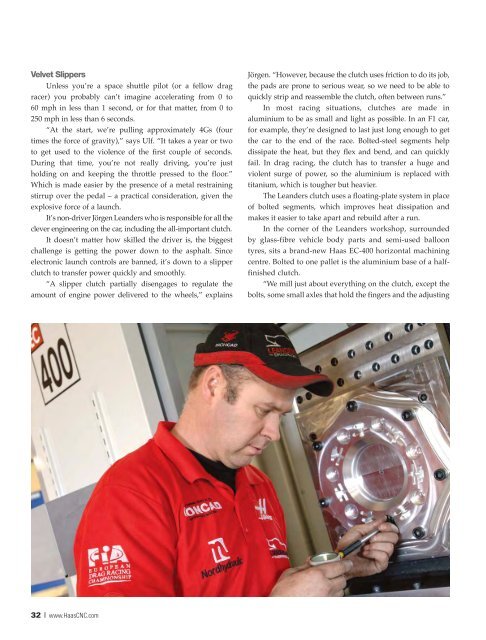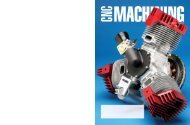The EC-630PP HMC - Haas - Haas Automation, Inc.
The EC-630PP HMC - Haas - Haas Automation, Inc.
The EC-630PP HMC - Haas - Haas Automation, Inc.
Create successful ePaper yourself
Turn your PDF publications into a flip-book with our unique Google optimized e-Paper software.
Velvet Slippers<br />
Unless you’re a space shuttle pilot (or a fellow drag<br />
racer) you probably can’t imagine accelerating from 0 to<br />
60 mph in less than 1 second, or for that matter, from 0 to<br />
250 mph in less than 6 seconds.<br />
“At the start, we’re pulling approximately 4Gs (four<br />
times the force of gravity),” says Ulf. “It takes a year or two<br />
to get used to the violence of the first couple of seconds.<br />
During that time, you’re not really driving, you’re just<br />
holding on and keeping the throttle pressed to the floor.”<br />
Which is made easier by the presence of a metal restraining<br />
stirrup over the pedal – a practical consideration, given the<br />
explosive force of a launch.<br />
It’s non-driver Jörgen Leanders who is responsible for all the<br />
clever engineering on the car, including the all-important clutch.<br />
It doesn’t matter how skilled the driver is, the biggest<br />
challenge is getting the power down to the asphalt. Since<br />
electronic launch controls are banned, it’s down to a slipper<br />
clutch to transfer power quickly and smoothly.<br />
“A slipper clutch partially disengages to regulate the<br />
amount of engine power delivered to the wheels,” explains<br />
32 | www.<strong>Haas</strong>CNC.com<br />
Jörgen. “However, because the clutch uses friction to do its job,<br />
the pads are prone to serious wear, so we need to be able to<br />
quickly strip and reassemble the clutch, often between runs.”<br />
In most racing situations, clutches are made in<br />
aluminium to be as small and light as possible. In an F1 car,<br />
for example, they’re designed to last just long enough to get<br />
the car to the end of the race. Bolted-steel segments help<br />
dissipate the heat, but they flex and bend, and can quickly<br />
fail. In drag racing, the clutch has to transfer a huge and<br />
violent surge of power, so the aluminium is replaced with<br />
titanium, which is tougher but heavier.<br />
<strong>The</strong> Leanders clutch uses a floating-plate system in place<br />
of bolted segments, which improves heat dissipation and<br />
makes it easier to take apart and rebuild after a run.<br />
In the corner of the Leanders workshop, surrounded<br />
by glass-fibre vehicle body parts and semi-used balloon<br />
tyres, sits a brand-new <strong>Haas</strong> <strong>EC</strong>-400 horizontal machining<br />
centre. Bolted to one pallet is the aluminium base of a halffinished<br />
clutch.<br />
“We mill just about everything on the clutch, except the<br />
bolts, some small axles that hold the fingers and the adjusting



